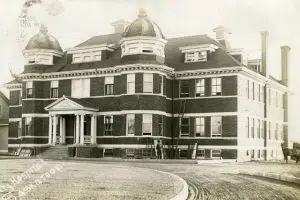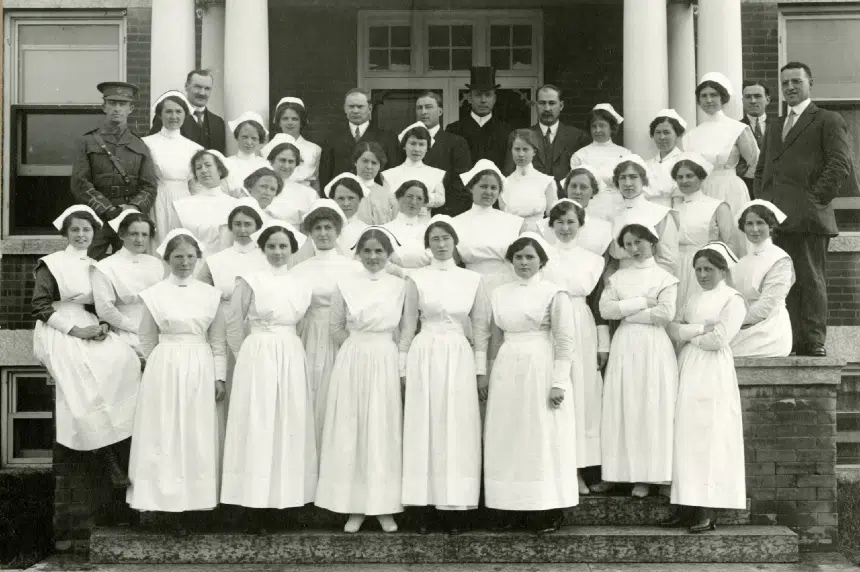As we continue to tread into uncharted territory with the COVID-19 global pandemic, Saskatoon’s city archivist gave 650 CKOM a glimpse into the past with how the city, and province, dealt with the Spanish flu in the early 1900s.
The outbreak began in Saskatchewan in October of 1918, and was similar in many ways, according to archivist Jeff O’Brien.
O’Brien joined Gormley Thursday morning to explain, and expand.
“In a lot of ways, it looked like today,” he said. “We sort of sat here in Saskatchewan, and we watched it come. We watched it come across the Atlantic on troopships (in) July and August.”
He said influenza first hit eastern Canada, before coming across on the nation’s railroads. The actions by many in power weren’t as proactive as we’re seeing in 2020, however.

Saskatoon City Hospital during the Spanish flu around 1918. (Saskatoon Public Library Local History Room – PH-88-980-10)
“A lot of it is the same kind of, ‘well, it’s somebody else’s problem,’ that changed, of course,” he said.
“(The federal government) said ‘no, it’s up to you, provinces,’ and the provinces said, ‘hey municipalities, health is a responsibility of a local board of health.'”
By mid-October in 1918, the province declared influenza a reportable disease. That meant influenza could be quarantined. The province followed that up with giving the local health board the right to close businesses.
O’Brien explained what happened next.
“Very quickly, (municipalities) ordered that all places of amusement be closed. The legislation only allowed them to close things like bowling alleys and theatres. Some people, including Saskatoon’s mayor, demanded wider powers. The ability to close the churches, the schools, to ban public meetings,” he said.
“The province was unwilling to do that.”
Even though the province didn’t comply, churches and schools closed thereafter. Meanwhile, restaurants and railways continued to operate with some changes to day-to-day work.
O’Brien says those in restaurants wore masks to stop the spread, while rail cars were disinfected nightly.
In Saskatoon, around 3,000 to 4,000 cases were reported, resulting in 324 deaths.
The province reported 5,040 deaths from influenza over just two years.
Nationally, about 55,000 people died.
“That’s as many as were killed in the first world war,” O’Brien said.
He added, the health care system quickly became overwhelmed. At that time many doctors were overseas in the army during the war.
Cities opened community kitchens, making meals to be delivered to those quarantined, or sick. “Local travelling salesmen,” O’Brien said, were tasked with knocking on every door in Saskatoon to find which homes had the flu.
“They identified 820 homes in Saskatoon that had the flu (in November of 1918), then they sent people out (to help).”
Around 200 women volunteered to help those who were sick, helping to keep fires burning with the return of winter around the corner, along with making meals and caring for people.
Of those 200 women, many ended up catching the flu, with some dying from it.
From the health system’s standpoint, two emergency hospitals were created to help those who fell ill. One was stationed at the University, while the other was set in Sutherland.
Those with mild cases were told to stay home, as doctors said they were already out of beds just a week into the outbreak. The first case was detected on October 15, 1918, with the first death coming six days later on Oct. 21.
In total, Saskatoon had 224 deaths in 1918 and 100 in 1919. Back then, the media also played a part in showcasing the toll the outbreak took on the city, O’Brien said.
“One guy writes about Saskatoon (in mid-November 1918), he says ‘Saskatoon is a city of the dead,’ he says, ‘on a Saturday night downtown, you’d normally expect cars and people to be lined up everywhere, and here I am, out on a Saturday, and there’s nobody. The streets are empty.'”
There were no aid packages given to citizens, and most reliefs were volunteer and charity-driven, O’Brien said.
One aspect that was a lot different during the Spanish flu pandemic was the population of Canada. It was estimated that Canada had just over 8.7 million people by 1921, with Saskatchewan boasting a total population of just over 757,000 at that time. In 1921 in Saskatoon, just over 25,700 people were living in the city.
Canada’s 55,000 deaths from the Spanish flu would be the equivalent of 220,000 deaths in 2020.
As for treatment, O’Brien said it was very similar to what we see today. Health officials stressed values of quarantine, hygiene, good diet and overall health in stopping the spread. They also stressed the importance of fresh air and exercise, and to avoid constipation.
There was no specific treatment but people were told to drink lots of fluids and get bed rest.
The Spanish flu led to changes in how Canada dealt with public health.
In 1919, the federal Department of Health was created, which established a partnership between the various levels of government.











